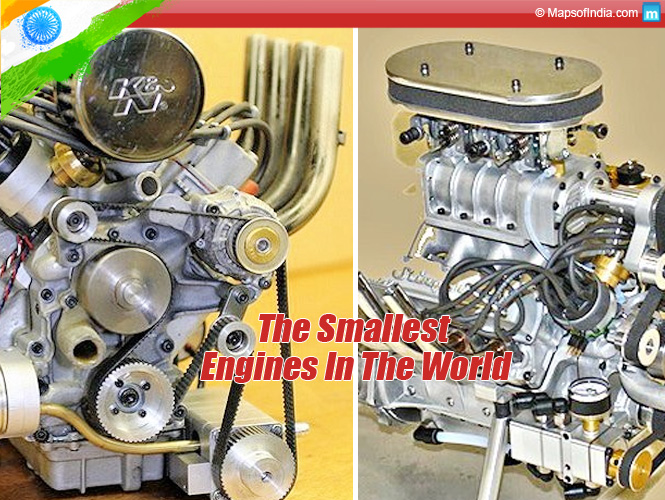Most of us know how an engine functions. Also how many types of engines there are. The fun comes in pondering on just how small they could get.
Scale model cars and planes have been powered by minuscule gasoline engines by RC (Radio Controlled) and scale model race enthusiasts for several years now. Some of the largest scale models available through conventional RC hobby centres one fifth or one sixth of the actual size on the scale but the more serious ones have even gone to the quarter.
Presently, the smallest (quarter scale) V8 gasoline engine in production is being shelled out by Coney Precision Engines. For all those slightly unaware of the workings of a V8 or what it looks like, for that matter – a V8 is a V-Shaped engine with eight cylinders mounted on the crankcase in two banks of four cylinders each, majorly set at right angles to each other but sometimes at narrower ones too, with all eight of its pistons driving one common crankshaft (Hell, yeah! that is serious power!).
A quarter scale fuel powered car is about four feet in length, weights around fifty kilograms and is well capable of achieving speeds of over 160 kmph. The engines for cars like these are p two cycle engines quite alike the ones that power weed pullers and leaf blowers, mostly beginning at 33 ccs in displacement and provide 3-4 horsepower at 6-8000 rpm.
The bigger engines for similar car models are simpler and quite reasonable when it comes to a builder’s or enthusiast’s budget. For example, a 160 cc displacing gasoline motor which provides for 17 horsepower at 9000 rpm, weighing 4 kgs can be made available at a US $ 1000. Okay maybe not that reasonable, but consider the amount of precision and attention put in to creating a perfectly sound, well functioning pocket-sized piece that churns out mindblowing performance even if one considers just the size. These mini monsters produce enough power for any quarter scaled car one would want to race.
Creating quite a stir in the pocket racing community is the recent “Conley Stinger 609”, a new quarter scale V8 with a 100 cc displacement, a power ouput of 9.5 horsepower at 10000 rpm and a supercharger! Because of the way it looks and how brilliantly it sounds, it does come at a slightly steeper price of over US$ 7000, but if you consider the quality and output, specially if you are an RC enthusiast looking to make it big at this year’s RC series championship, this is probably what you would happily go in for.
Then there’s an enthusiast who has surprised all with his working LEGO V8, made just from the children’s favourite building blocks. This tiny motor peaks out at 1780 rpm, made possible by the addition of timing gears in the rear end to prevent torsion in the crank and cam, and currently runs in a double cam setup.
Among the world’s smallest engines is another one constructed with a combination of stainless steel, bronze and aluminium – which also makes it one of the lightest in the tiny category, and runs off compressed air, displacing 12 CCs.
The lightest and tiniest engine is still smaller, measuring just five inches in length and a displacement of just 44 cc. This tiny V8 is completely hand built by its creator except for a few standard parts like the OS carburettor, and ME8 spark plugs.
Among the most recent and amazing ones is Johannes Robnagel’s four stroke. Like all gasoline engines it works and performs in the four standard steps of compression, heating, expansion and cooling – repeating over and over again, the same cycle, transforming the changing temperature into mechanical energy.
Except for one tiny little detail. Yes, the detail is tiny enough to be on the atomic scale. Robnagel’s engine is not a V8. Infact, its not even an internal combustion engine. An experimental physicist at the university of Mainz in Germany, Johannes Robnagel, has conceived and is in the process of building the tiniest engine ever built – less than a micrometer in length!
The microscopic powerhouse runs on a single atom and in the arguments of its inventors – because of the anomaly of quantum physics, will also be by far the most fuel efficient engine ever.
To make a scale model look and perform the part, it is very important to choose what materials are required to be utilised and which ones can add to unnecessary weight. Because of the way they’re built, RC cars put much less weight, even in relative comparison, on their tires. This can cause poor handling and performance as the massive power from the tiny engines can cause tires to break free and spin out specially on tight corners or turns, wasting the power produced by the engine.
However, most of the fun and excitement of RC racing is the sound of the car, majorly, the engine. Nothing in the world sounds like a V8 turning over and running up through the power curve. The low speed rumble, and then the screaming wail at high speeds adds excessively to the fun and joy of this sport.
At the end of the day, every racer wants his engine to sound right, even if it is just about the size of their pocket or wails at two octaves higher.




